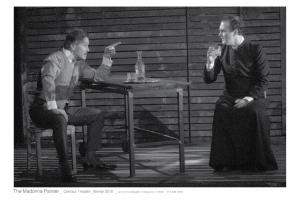The Madonna Painter, The Birth of Painting at the Centaur, is a richly imagined, sacrilegiously macabre, exercise in which playwright Michel-Marc Bouchard delves into long-discarded French-Canadian Catholic ritual and rural ignorance, “the way a flea market hawker displays sacred objects that have been stolen and disguised for resale.”
The play takes place in northern Quebec during the 1918 Spanish flu epidemic when a handsome, idealistic young priest (Graham Cuthbertson) arrives in a backwoods community and commissions an immigrant Italian artist (Alessandro Juliani – who incidentally is the best thing about the production) – to paint a fresco of the Virgin Mary to protect his parishioners from the ravages of the disease.
The villagers are convinced that English-Canadian soldiers returning from the war are deliberately spreading the virus through Quebec to decimate French-Canadians. The emphasis in the Centaur production is on the play’s subtitle, The Birth of Painting. It is all about how the work involves both the mortification and the celebration of the flesh.
 Originally staged in French, Linda Gaboriau’s translation doesn’t quite capture the winsome poetry of the original. Three young girls in the village compete to be the model for the triptych, Marie-Louise (Lucinda Davis), who picks through other people’s laundry to read their secrets, the sassy Mary Ann (Amelia Sargisson), and the chaste Mary Frances (Stefanie Buxton).
Originally staged in French, Linda Gaboriau’s translation doesn’t quite capture the winsome poetry of the original. Three young girls in the village compete to be the model for the triptych, Marie-Louise (Lucinda Davis), who picks through other people’s laundry to read their secrets, the sassy Mary Ann (Amelia Sargisson), and the chaste Mary Frances (Stefanie Buxton).
The seductive Italian artist, however, decides to be inspired by Mary of the Secrets (Meg Roe), who has a mysterious, troubled past of her own. The painter turns out to be a misogynist who seduces his models then abandons them to capture their painful expressions on canvas.
Then there’s the agnostic village doctor (Jean Leclerc), who dissects bodies looking for their souls. As the doctor, Leclerc seems to have wandered on stage thinking he is still on Broadway playing Dracula.
“It is not so good for a man to be so handsome, especially a priest,” he warns the cleric in a booming ghoulish voice. “Someday, when you are ready, I would like to do your autopsy.”
Sure enough, Graham Cuthertson’s priest ends up being brutally victimized, but his anguish needs to be reigned in a bit. It has all been directed with an over-emphatic hand by Roy Surrete. The stylized set by Pierre Etienne Locas puts a kitchen sink front and centre, and it winds up being used as a holy water fount, a forest spring, and a bloody hospital basin. It gives nothing away to say the most shocking scene has nothing to do with bloodied sacred hearts and other amputated body parts, but a bit of good flagellation. Sadomasochists will have a good time.

























Comments
Please login to post comments.